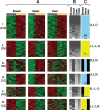P-value evaluation, variability index and biomarker categorization for adaptively weighted Fisher's meta-analysis method in omics applications
- PMID: 31359040
- PMCID: PMC7867999
- DOI: 10.1093/bioinformatics/btz589
P-value evaluation, variability index and biomarker categorization for adaptively weighted Fisher's meta-analysis method in omics applications
Abstract
Motivation: Meta-analysis methods have been widely used to combine results from multiple clinical or genomic studies to increase statistical powers and ensure robust and accurate conclusions. The adaptively weighted Fisher's method (AW-Fisher), initially developed for omics applications but applicable for general meta-analysis, is an effective approach to combine P-values from K independent studies and to provide better biological interpretability by characterizing which studies contribute to the meta-analysis. Currently, AW-Fisher suffers from the lack of fast P-value computation and variability estimate of AW weights. When the number of studies K is large, the 3K - 1 possible differential expression pattern categories generated by AW-Fisher can become intractable. In this paper, we develop an importance sampling scheme with spline interpolation to increase the accuracy and speed of the P-value calculation. We also apply bootstrapping to construct a variability index for the AW-Fisher weight estimator and a co-membership matrix to categorize (cluster) differentially expressed genes based on their meta-patterns for intuitive biological investigations.
Results: The superior performance of the proposed methods is shown in simulations as well as two real omics meta-analysis applications to demonstrate its insightful biological findings.
Availability and implementation: An R package AWFisher (calling C++) is available at Bioconductor and GitHub (https://github.com/Caleb-Huo/AWFisher), and all datasets and programing codes for this paper are available in the Supplementary Material.
Supplementary information: Supplementary data are available at Bioinformatics online.
© The Author(s) 2019. Published by Oxford University Press. All rights reserved. For permissions, please e-mail: journals.permissions@oup.com.
Figures

Similar articles
-
Accurate and efficient estimation of small P-values with the cross-entropy method: applications in genomic data analysis.Bioinformatics. 2019 Jul 15;35(14):2441-2448. doi: 10.1093/bioinformatics/bty1005. Bioinformatics. 2019. PMID: 30521030 Free PMC article.
-
A U-statistics for integrative analysis of multilayer omics data.Bioinformatics. 2020 Apr 15;36(8):2365-2374. doi: 10.1093/bioinformatics/btaa004. Bioinformatics. 2020. PMID: 31913435 Free PMC article.
-
MetaKTSP: a meta-analytic top scoring pair method for robust cross-study validation of omics prediction analysis.Bioinformatics. 2016 Jul 1;32(13):1966-73. doi: 10.1093/bioinformatics/btw115. Epub 2016 Mar 2. Bioinformatics. 2016. PMID: 27153719 Free PMC article.
-
Identifying interactions in omics data for clinical biomarker discovery using symbolic regression.Bioinformatics. 2022 Aug 2;38(15):3749-3758. doi: 10.1093/bioinformatics/btac405. Bioinformatics. 2022. PMID: 35731214 Free PMC article.
-
Meta-analysis based on weighted ordered P-values for genomic data with heterogeneity.BMC Bioinformatics. 2014 Jun 28;15:226. doi: 10.1186/1471-2105-15-226. BMC Bioinformatics. 2014. PMID: 24972803 Free PMC article.
Cited by
-
Transcriptomic meta-analysis reveals ERRα-mediated oxidative phosphorylation is downregulated in Fuchs' endothelial corneal dystrophy.PLoS One. 2023 Dec 14;18(12):e0295542. doi: 10.1371/journal.pone.0295542. eCollection 2023. PLoS One. 2023. PMID: 38096202 Free PMC article.
-
Comparative Pathway Integrator: A Framework of Meta-Analytic Integration of Multiple Transcriptomic Studies for Consensual and Differential Pathway Analysis.Genes (Basel). 2020 Jun 24;11(6):696. doi: 10.3390/genes11060696. Genes (Basel). 2020. PMID: 32599927 Free PMC article.
-
Molecular characterization of cell types in the squid Loligo vulgaris.Elife. 2023 Jan 3;12:e80670. doi: 10.7554/eLife.80670. Elife. 2023. PMID: 36594460 Free PMC article.
-
Deciphering the causal relationship between blood pressure and regional white matter integrity: A two-sample Mendelian randomization study.J Neurosci Res. 2023 Sep;101(9):1471-1483. doi: 10.1002/jnr.25205. Epub 2023 Jun 18. J Neurosci Res. 2023. PMID: 37330925 Free PMC article.
-
Central insulin dysregulation in antipsychotic-naïve first-episode psychosis: In silico exploration of gene expression signatures.Psychiatry Res. 2024 Jan;331:115636. doi: 10.1016/j.psychres.2023.115636. Epub 2023 Nov 26. Psychiatry Res. 2024. PMID: 38104424 Free PMC article.
References
-
- Benjamini Y., Heller R. (2008) Screening for partial conjunction hypotheses. Biometrics, 64, 1215–1222. - PubMed
-
- Benjamini Y., Hochberg Y. (1995) Controlling the false discovery rate: a practical and powerful approach to multiple testing. J. R. Stat. Soc. Series B Methodol., 57, 289–300.
-
- Birnbaum A. (1954) Combining independent tests of significance. J. Am. Stat. Assoc., 49, 559–574.

